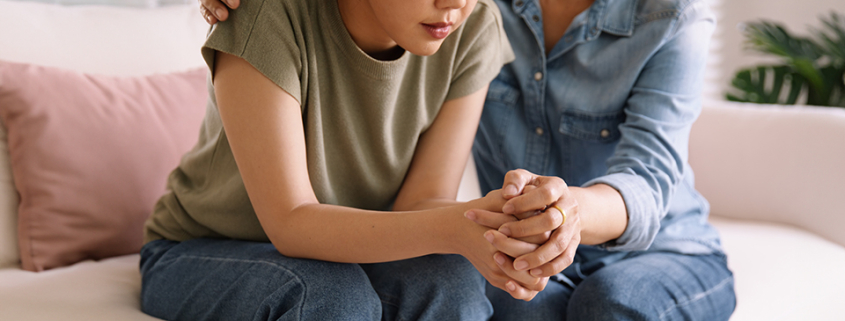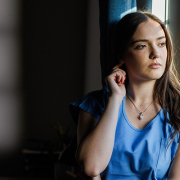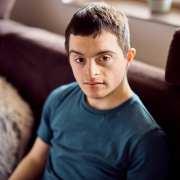Anxiety in children and how parents can support their child
Anxiety, worry, and fear are all natural emotions. Anxiety usually involves a feeling of apprehension or nervousness about potential negative events and can lead to uncomfortable physical reactions. These emotions will most likely result in behaviours such as avoidance, seeking reassurance or irritability (known as the flight or fight stress response).
It’s normal for children to experience feelings of anxiety as a part of growing up, but due to the varying nature of humans and their responses, it can emerge differently during the different developmental stages. Mostly, these emotions don’t persist for long periods of time.
Feelings of anxiety across the developmental stages of a child
Babies and toddlers frequently display anxiety related to separation from their caregivers (e.g., crying when their caregiver is no longer in sight) and might react to loud noises, heights, and unfamiliar people with further tears.
Pre-schooler’s may continue to experience some anxiety related to separation from caregivers, as well as develop some fears of being alone, being in the dark, and that they, or their caregiver, may become sick or injured.
As children enter school age, different fears develop as they start to understand that they are a separate entity from their caregivers. They may then report fears of supernatural entities like ghosts, social situations, criticism, tests, and physical harm.
By the time children reach the age of 8 and beyond, their worries might expand to include concerns about school performance, global issues like war or pandemics, environmental issues, and family and friend relationships.
All of these are normal and talking about them with the child will normalise it for them and will often lead to healthy conversations about strategies to cope.
Common signs of problematic anxiety in children
Some signs of problematic anxiety that parents can be aware of include:
Excessive worrying: Children with anxiety often worry excessively about everyday events, school, friendships, or family matters. The key sign to look for is the worrying reported can be out of proportion to the situation.
Physical signs and symptoms: Anxiety can manifest as physical symptoms such as stomach aches, headaches, muscle tension, sweating, and trembling, even when there’s no apparent physical cause.
Sleep disturbances: Anxious children may have difficulty falling asleep, staying asleep, or experience frequent nightmares related to their fears and worries.
Avoidance behaviours: They may avoid situations, places, or activities that make them anxious. For example, a child might refuse to go to school, attend social events, or avoid specific places or people.
Perfectionism: Some anxious children set unrealistically high standards for themselves and become overly self-critical. They may be afraid of making mistakes or being judged by others.
Irritability: Anxiety can make children more irritable, agitated, or prone to outbursts of frustration or anger, especially when they feel overwhelmed.
Reassurance seeking: Anxious children may repeatedly seek reassurance from parents or caregivers, asking for confirmation about their fears or worries.
Difficulty concentrating: Anxiety can affect a child’s ability to concentrate and focus on tasks, leading to academic difficulties.
Social withdrawal: Some anxious children become socially withdrawn, avoiding interactions with peers and preferring to be alone.
Physical restlessness: Restlessness or fidgeting can be a sign of anxiety in children. They may have trouble sitting still or relaxing.
Clinginess or separation anxiety: Younger children may become excessively clingy to their parents or caregivers, even in situations where it’s developmentally inappropriate.
Exaggerated fears: Children with anxiety may have exaggerated fears about specific situations, objects, or events. Common fears include fear of the dark, animals, heights, or storms.
Difficulty transitioning: Anxious children may struggle with transitions, such as moving from one activity to another or transitioning to a new school or grade.
Negative self-talk: They may engage in negative self-talk, expressing feelings of worthlessness or self-doubt.
It is important to remember that not all children will display all these signs, and the severity of symptoms can vary across different ages. Bear in mind that some level of anxiety is normal in children, but when it interferes significantly with daily life and functioning, it may be an anxiety disorder.
If parents notice persistent signs of anxiety in their child causing distress or impairment, it’s advisable to seek professional help from a medical practitioner or psychologist for evaluation and guidance.
Strategies for supporting a child with anxiety
Whether you’re seeking professional help or not, there are some things you can do as a parent to support children experiencing anxiety. These strategies can help to create a supportive and calming environment for your child while also offering some protection to their self-confidence and self-esteem.
Open and non-judgmental communication
Create a safe space for your child to talk about their feelings and fears. Listen actively and without judgment. Avoid dismissing their worries as silly or accusing them of overreacting. Show empathy and understanding, so your child feels comfortable sharing their thoughts and emotions with you.
Model healthy coping mechanisms
Children learn a lot by observing their parents. Self-check your own anxiety – how do you manage stress and anxiety? Model and teach children how to cope with stress and anxiety in healthy ways. This might include learning to expressing your emotions in healthy ways (both negative and positive) and pro-actively regulating your emotions. You might like to practice relaxation techniques like deep breathing or mindfulness exercises together.
Promote healthy lifestyle choices
Ensure your child gets enough sleep, eats a balanced diet, and engages in regular physical activity. Exercise is an important way to help your child deal with the psychological and mood effects of anxiety.
Maintain predictable routines
Children with anxiety often benefit from routines, as having a predictable schedule can reduce uncertainty and anxiety triggers. Maintain consistent bedtimes, mealtimes, and homework routines for your child. Give them adequate notice when things change, as knowing what to expect can help them feel more secure.
Limit exposure to stressors
Be mindful of your child’s exposure to stressors, such as violent media (including gaming) or excessive academic or sport pressures. Create a balanced environment that prioritises your child’s well-being over external pressures.
Encourage problem solving
Teach your child problem solving skills. When they encounter an anxiety-provoking situation, help them break it down into smaller, manageable steps. Encourage them to be curious and brainstorm solutions and then recognise their efforts, even if the outcome isn’t perfect. For example, if a child is worried about a global event such as climate change, get them to do small things like empty their water bottle into plants, rather than waste water.
Gradual exposure and the stepladder approach
For children with specific fears or phobias, use a technique called gradual exposure. Start with small steps to confront the fear and then gradually increase the challenge as your child becomes more comfortable. This can help desensitize them to the anxiety trigger.
Using this stepladder approach can help children manage smaller anxious challenges, and allow them to build confidence in managing tasks that generate more anxiety as they practice. For further information, please refer to: https://raisingchildren.net.au/toddlers/health-daily-care/mental-health/anxiety-stepladder-approach
Celebrate small achievements
Encourage your child to face their fears, and celebrate their achievements, no matter how small. Positive reinforcement can boost their self-esteem and confidence.
Set realistic expectations
Remember to truly aim to understand your child’s limitations and set realistic expectations. Practice meeting your child at the stage they are at, rather than where you think they should be. If you find yourself becoming impatient and frustrated, take time and talk to someone. Avoid pushing children too hard, as this can increase their anxiety. Try to maintain your focus on their wellbeing and efforts rather than them achieving a standard, or perfection. Parenting is a long-term activity and setting realistic expectations for yourself will assist your children in achieving this too.
When to seek professional help
If your child’s anxiety significantly impacts their daily life, consider seeking help from a mental health professional. Therapy, such as Cognitive Behavioural Therapy (CBT), can be highly effective in treating anxiety disorders in children.
Keep in mind that every child and family is unique, and what works for one may not work for another. Be patient and flexible in your approach, and always prioritise your child’s emotional wellbeing. It is possible to work towards creating a loving and supportive environment that helps your anxious child build confidence and self-esteem while also managing their anxiety effectively.
Support helplines
When seeking support, remember that you are not the first person to have done so and will certainly not be the last. Take small steps and remember that 1% is better than 0%.
https://raisingchildren.net.au/grown-ups/services-support/about-services-support/helplines
https://www.beyondblue.org.au/get-support/parenting
Further Reading and resources:
https://www.copingcatparents.com/Books_for_Parents_and_Kids
https://raisingchildren.net.au/
https://headspace.org.au/explore-topics/for-young-people/anxiety/
The information provided in this document is general in nature and is intended to be used for information purposes only. While we have tried to ensure the accuracy of the information published, no guarantee can be given that the information is free from error or omission or that it is accurate, current or complete.
The information published is not, and should not be relied on as, health or treatment advice. The diagnosis and treatment of any mental illness requires the attention of a physician or other properly qualified mental health professional. If you are seeking diagnosis or treatment of any other mental illness, you should consult a physician or mental health professional. You should not delay in seeking, or disregard, professional health advice because of something you have read in this document.









